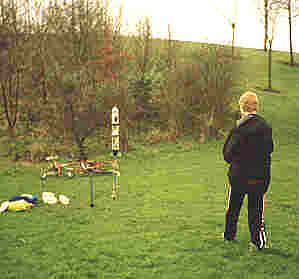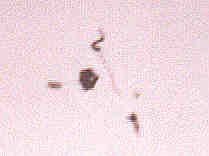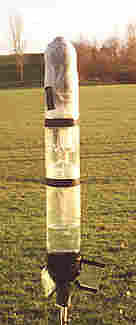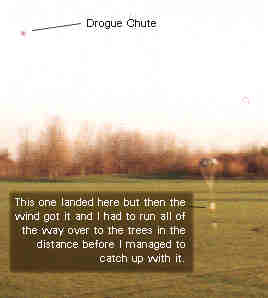|
|
Water Rocketry - Aerial Photography Pictures of the Mk I
camera
The first set of photographs
were taken from site 1 . . .

This is from site 2

 This day's helper. Note that by
using the smaller 2 litre rocket, I can carry the
whole setup on a push-bike. This day's helper. Note that by
using the smaller 2 litre rocket, I can carry the
whole setup on a push-bike.It was fairly windy
that say and the hill that you can see was a good
shelter for the rocket while it was on the
launcher. However, when it got into the air and
the wind hit it, that was a different story.
|
 looking straight up, a rare shot of
the 'Z' shaped fold in the process of opening
out. looking straight up, a rare shot of
the 'Z' shaped fold in the process of opening
out. Packing the chute and the cords in this
way means that there are no tangles to undo at
altitude.
|
 In another sheltered
spot. By this time, the grass had got so
muddy that I found this spot only a few feet
onto the field - there are some bushes behind
me giving shelter. In another sheltered
spot. By this time, the grass had got so
muddy that I found this spot only a few feet
onto the field - there are some bushes behind
me giving shelter.This time, as I was
using only a single 2 litre bottle for power,
I used the bin-liner to save on weight -
every little helps and the 20 gramme saving
helped.
Until the wind hit it of course.
|
 The drogue carried
on for a little longer but as I approached
the rocket, the wind caught in the parachute
and the whole thing started to get dragged
across the field. The drogue carried
on for a little longer but as I approached
the rocket, the wind caught in the parachute
and the whole thing started to get dragged
across the field.As I ran and got closer,
it would slow down, as if to let me get a
hold of it but every time I got only a few
yards away from it, another gust of wind
would come and take it well out of my reach.
Finally, I managed to catch up with if
only a few yards in front of the trees in the
distance.
The camera had fallen out a hundred feet
or so before this and the mechanism was
covered in mud and broken. Funnily enough,
the drogue didn't go walkies in the same way
as the main chute - it was as good as gold.
|
Back
to the MkI camera . . .
To
the pictures taken with the camera . . .
 Back to the Water Rocket Index Back to the Water Rocket Index
|
|